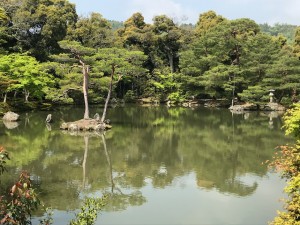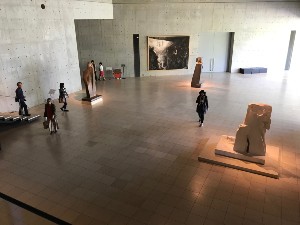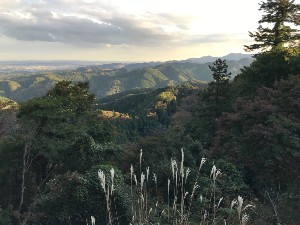Shodo Island and Shimanami Kaido

This trip started in Nagoya, so we had to take a train the night before the tour to get there from Tokyo. We had always wanted to explore Nagoya anyway, so no problem doing that.
We arrived in Nagoya in the evening, so we did not have much time to explore. But, we did take a ride on the tourist bus that goes between each of the major attractions in the city. That gave us an idea of where they were located, and what we were actually interested in seeing when we returned from the tour. That evening we went out to dinner at one of the many izakayas near our hotel, and sampled a couple of their specialities.
Day One
The following day we had to meet the tour group at Nagoya station at 7:15am. Fortunately, the meeting place was easy enough to find and the number of people in the tour was not as many as we expected - only around 15 people including ourselves.
So, our first step was to take a Shinkansen ride to Okayama. That took about two hours or so. A bus was there to meet us, and off we went. We were next heading to Okayama port, where we would take a ferry ride to the Tonosho port on Shodo Island. The bus, with us on it, drove right onto the ferry. We then got off the bus and preceded to climb up to the higher levels of the ferry, where there were splendid views of the harbor as well as the small islands around Shodoshima.
We all went back on the bus, and drove to our first attraction - an Olive Garden. No, not the restaurant! An actual garden where they grow olive trees. Frankly the name "olive garden" was not really a good translation, as it is more of a olive tree orchard. Anyway, it was close to the water so we had some very nice views from the hillside, as well as the building where we had lunch. Lunch was great. A bed of white rice with a layer of ground pork, with the top portions filled with fresh vegetables and other goodies. Very tasty. Easily the best lunch on the trip.


It was time for something different. We drove next to Kankakei Ropeway, which was a winding road leading up the mountainside. The gondola takes you up to the top of the mountain. Quite a ride going up. I can only imagine how pretty it must be in the fall when the leaves change color. At the top you can see some awesome views of the islands dotting the ocean waterways.


Our afternoon was spent driving to a peninsula at the southeast part of the island. There, a schoolhouse was made famous by a movie made in the 1950's called "Twenty Four Eyes" (Nijushi no Hitomi). The movie is about a teacher that arrives on Shodo island to teach a first grade class at a "simpler" time in history. The leading role is played by Hideko Takamine, a well known actress during this period. There are two locations to check out for those interested in this movie. One is the place we toured, which is the original schoolhouse used for the movie in 1954. The second is a movie village that was created for a remake of the movie in 1987.

That evening we stated at the Bay Resort Hotel Shodoshima. An older hotel though partially refurbished, it's rooms are pseudo-Japanese style, with low beds and tatami mat floors. Our room, and I expect most rooms in the hotel, had a beautiful view of the bay.

Day Two
The next day we drove to Olive Park. It was similar to the Olive Garden we visited yesterday, but much larger. There are acres of olive trees, and a number of artifacts that signify the connection to Greece, the source of the original olive trees planted in Japan. There is even a hotel in the park if you want to savor the various olive based products that are on sale in the gift shop. They include olive oil, olive cookies, olive hand cream, and olive based seasonings.


Next stop on the tour was Angel Road. Ok, there are no angels. And, there isn't really a road either. Move of a pathway. Ok, what is this place? Well, first of all, Angel Road is right on the coast. It connects the island with a tiny spit of land that is perhaps 50 meters away. The road is only visible at low tide - about 8 hours a day. Sure, it is a tourist trap, and we could have easily skipped it.

It was time to leave Shodoshima, and so after Angel Road we drove to the nearest port and rode a ferry to Takamatsu.
Upon arrival, it was getting close to lunchtime so we headed off to Goyashiki, an udon restaurant not far from the port. We noted that the noodles were a bit more firm than we were used to in Tokyo, but I liked it enough to finish the whole bowl. There were a lot of noodles in that bowl, and wow, some people were asking for seconds. I think they are just swallowing the noodles without chewing! I should note that the restaurant is in a rather old building of traditional Japanese style surrounded by a small but pretty garden.


Following lunch, we did quite a bit of driving to reach Imabari. The drive took a couple of hours in total, with some freeway rest stops sprinkled in. Our next stop was the Towel Museum. Ok, I have never heard of a towel museum, so I had no idea what to expect. On the fifth floor, there was an exhibition of towels made with certain themes in mind, like Moomie, Disney, and other well know themes. The other floors were basically an expansive selection of towels for sale. As I found out later, this area of Japan is known for its towel manufacturing businesses. Toyoko acted like a good shopper and purchased as many as she could carry. Dinner was adjacent to the towel museum in a Chinese restaurant that will go nameless because I would rather you didn't go there and be disappointed like we were. Oh, and don't miss the illumination lights if you are there in the evening.


We stayed at the Imabari Kokusai Hotel that night. A modern skyscraper, every room had a great view of the surrounding area. Unfortunately, the surrounding area was not that interesting.
Day Three
Our next day was pretty much dedicated to exploring the islands that are strung together by the Shimanami Kaido. Our first stop was Kinosan Observatory, a platform that provides wonderful views of the Kurushima-Kaikyo Bridge and surrounding islands. It's located at the top of Mt. Kiro at the southern part of Oshima Island. The multi-level platform was designed by Kengo Kuma, an acclaimed architect. There are some steps to get up to the top so be prepared.

Next was Oyamazumi Jinja. This was not an out of the ordinary Shinto shrine except for its famously old trees. There is a live tree here that is over 2500 years old! There's even the remains of a tree over 3000 years old.

Similar to our stop at Angel Road on the previous day, we next stopped at Setoda Sunset Beach on Ikuchi Island in Hiroshima Prefecture. The beach provided a few outdoor works of art, but other than that nothing else. I can see that this place would be hopping during the summer, but all the shops were closed and so we were just wondering aimlessly, killing time until we were told to board the bus.
Our last stop on the tour made up for Sunset Beach. We visited Kosanji Temple and the Hill of Hope. This complex was something to behold. The temple, located on Ikuchijima, belongs to the True Pure Land Sect of Japanese Buddhism. One of the highlights for me was the long cave tunnel that depicted images of hell in Buddhism. Quite an eye opener! The other highlight is the Miraishin no Oka, or Heights of Eternal Hope for the Future. The entire exhibit is made entirely of white Italian marble - including the floors. There's even an Italian restaurant on the site.



Back to Nagoya
By evening we were back on the Shinkansen heading from Okayama to Nagoya. We saw a lot in these past few days, despite a couple of clunkers. The weather held up nicely and we learned more about Japan.
In Nagoya, we did stay one more night, and the following day went to visit the Nagoya Castle, Tokugawa park, and some old homes that are now historical treasures. Overall a great trip.






































